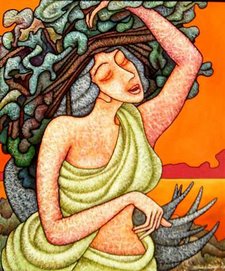
As you enter the complex on your left is Mohamad Ali's Jewel Palace which was destroyed to a large extent in an elctrical fire, and, now is in the process of being restored.
As you walk down on your left is the famous Mohammad Ali mosque, also known as the Alabaster mosque because of the alabaster used on the exterior and interior walls and the courtyard. It is said that it was designed to emulate the style of the royal Ottoman mosques of Istanbul, and, that the architect was the same man who built the Haga Sophya in Istanbul.
The mosque has 3 domes which are designed to be utilitarian. I believe the domes help to keep the mosque cool and also cause resonance which is useful during prayers. The domes on the exterior are covered with lead sheets which is what gives the mosque is silver sheen in sunlight.
If you look at the walls of the mosque, there are only 3 types of decorations - floral, geometric and calligraphy.. Islam does not permit worship of statues which is why you dont see any.
In the centre of the courtyard is an octagonal gazebo like structure which is the ablution fountain which is very much in use even today. A little ahead, on the right side is the ablution well from which the water was drawn before taking it to the gazebo to complete the cleansing process..
In the middle of the western side of the outer courtyard, stands a brass clock-tower, which was
presented in 1845 to Muhammad'Ali by Louis Philippe, King of France, in return for the obelisk which adorns the Place de la Concorde in Paris today. It is said that from the day it was gifted, the clock never worked! So clearly, King Louis Philippe did not appreciate his gift too much!!!
When you enter the mosque, the first thing that strikes you is this huge circular rail on which hundreds of lamps seem to be twinkling. While I did not have the energy to count, it is said that the rail has as many lamps as the number of days in the year i.e. 365. Can you imagine the plight of the vassal who had to light the oil lamps every day at sunset, and , then put them off after sunrise!!
In front of you, is a small curvature in the wall which prepresents the dierction of Kaba, and, is called the Mehrab. On the top part is a gilded half-sun which was the logo of the Ottoman empire. In fact, this logo can be seen in many places on the exterior and interior walls...
On the right of the Mehrab, you can see two sets of decorated flight of stairs. This is the "member" and from here the priest calls out the noon prayers. The original member is made from wood and decorated with the logo of the Ottomans. The new green one was gifted by King Farookh who was the last ruler who ruled Egypt.
Adjacent to the entrance, on your right, is where Mohamad Ali was buried. A stone reproduction of his hat adorns the grave at the top, and, a Holy Quran is placed on the grave.
When you look up, there is a balcony running along the walls of the mosque. This is the segregated prayer area for women when they come to pray at this mosque. This moque is an actively used mosque, so is closed to tourists for Friday afternoon prayers. So plan your trip accordingly, if planning to visit the Citadel on a Friday.

No comments:
Post a Comment